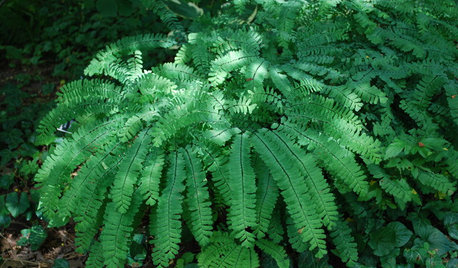How did Great, great, great, great Grandmother..
alicate
17 years ago
Related Stories

HEALTHY HOMEHow to Childproof Your Home: A Grandmother’s Wisdom
Change kids’ behaviors, not your entire house, to keep the designs you like and prepare children for reality
Full Story
GARDENING GUIDESGreat Design Plant: Northern Maidenhair Fern Softens Shade Gardens
Stir up some romance in dark corners with the billowy fronds of native Adiantum pedatum
Full Story
LIFEKitchen Traditions: Tomato Season Meets a Family Legacy
Somewhere a Sicilian great-great-grandmother is smiling at a bowl of American-made sauce
Full Story
PATTERNGo for the Bold: 14 Great Ideas for Patterned Upholstery
Dare to distance yourself from neutral, solid furniture fabrics for rooms that spring to life
Full Story
DECORATING GUIDESCelebrating the Great American Quilt
They speak of family, history and beauty. Is it any wonder quilts transcend design styles?
Full Story
KITCHEN COUNTERTOPSKitchen Countertop Materials: 5 More Great Alternatives to Granite
Get a delightfully different look for your kitchen counters with lesser-known materials for a wide range of budgets
Full Story
FURNITURE10 Traditional Pieces That Look Great in Modern and Contemporary Spaces
You can’t go wrong with these classic furnishings, no matter the style of your home
Full Story
MOST POPULAROvernight Guests Coming? How to Be a Great Host
Ensure a good time for all — including yourself — by following these steps for preparing for and hosting houseguests
Full Story
STUDIOS AND WORKSHOPS6 Artist's Studios That Model Great Design
Brush up on what makes a successful space for painting, sculpting and woodworking by checking out these inspiring outposts
Full Story
DECORATING GUIDESGreat New Looks for an Accessory You Already Own
Give handrails and walls the same warmth as your toes by using blankets as decor
Full StoryMore Discussions






veggiecanner
Violet_Z6
Related Professionals
Horsham Landscape Architects & Landscape Designers · La Marque Landscape Architects & Landscape Designers · Forest City Landscape Architects & Landscape Designers · Bethlehem Landscape Contractors · Estelle Landscape Contractors · Fort Worth Landscape Contractors · Lyndhurst Landscape Contractors · Middletown Landscape Contractors · Milton Landscape Contractors · Northbridge Landscape Contractors · Old Saybrook Landscape Contractors · Tamarac Landscape Contractors · Wallingford Landscape Contractors · Westchester Landscape Contractors · Chicago Driveway Installation & MaintenanceViolet_Z6
zeedman Zone 5 Wisconsin
alabamanicole
Violet_Z6
alabamanicole
digit
zeedman Zone 5 Wisconsin
Violet_Z6
farmfreedom
zeedman Zone 5 Wisconsin
zeedman Zone 5 Wisconsin
alicateOriginal Author
ceresone
zeedman Zone 5 Wisconsin